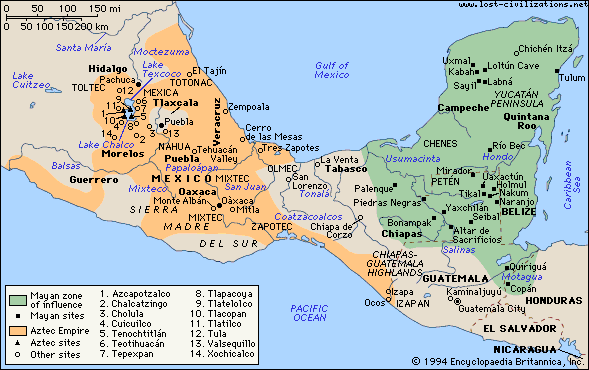The Maya nation is an homogeneous group of people who have occupied roughly the same territory for thousands of years. They speak some thirty languages that are so similar that linguists believe that they all have the same origin, a proto Mayan language that could be as much as 7000 years old! They will will explain how geographical isolation made the original language evolve towards an eastern branch subdivided into proto-K'iche and Mam and a western branch subdivided into proto-Q'anjob and proto-Tzeltal and how the further division of these sub branches gave rise to the 30 languages spoken today. The in situ evolution of their language implies that they were the original permanent inhabitants of the Maya area and suggests that that today's two million Mayas probably share a very ancient common genetic origin.
That is quite different from the warlike Aztec and Inca nations who invaded their neighbours and absorbed their populations by imposing their language, customs and religion. The Aztecs were a small ambitious "Chichimec" (savage) tribe from the north west who migrated into new lands, absorbed new ideas, evolved further and grew powerful enough to impose their language and gods (Huitzilopochtli), on the indigenous people they conquered. It is the story of outsiders becoming the governing elite of pre-existing populations for a relatively short time. The Incas of Cuzco were also a short lived foreign elite governing a wide variety of pre-existing nations.
The Maya had no centralised political leadership. They developed a common culture by absorbing and developing elements borrowed from their neighbours. The long count calendar, writing with glyphs and the basic tenets of their religion can be traced directly to the Olmecs through Izapa. The Olmec civilisation disappeared before the advent of the Christ but its heritage formed the basis for all other mezoamerican civilisations such as the Monte Alban Zapotec, the great Teotihuacan hegemony, the Tula Toltecs and finally the Aztecs.
The Maya were also influenced by Teotihuacan that controlled the Mexican highlands from the first to the seventh centuries. The Mayan golden age lasted five centuries from 300 to 800 AD. Then, they stopped building temples, declined and became fragmented in competing states that were easy prey for invading forces from the north such as the Toltec which had been expelled from Tula around the end of the 10th century. The Toltecs became the ruling elite of the Maya in the post classic period. Toltec gods were added to the Maya pantheon but the Toltecs were absorbed as they leaned to speak Yucatec Maya.
The Maya were organised in city states, sometimes co-operating, sometimes fighting each other but they shared the same beliefs and deferred to priests who derived power from their knowledge of astronomy, mathematics and numerology. The Maya were very much aware of the passage of time. They recorded some dates on stelae and probably much more in books that are lost now because fanatical Spanish Catholic priests destroyed them to eradicate "pagan beliefs". Retracing the history of the Maya is like finding the solution of a detective novel for we have to rely on whatever clues we can find in what is left of archaeological sites that the Spanish did not plunder or destroy.
There are many unanswered questions about the Maya but the cause of their decline remains the greatest mystery. Their civilisation was not destroyed by an overwhelming outside force. The Olmec suffered the destruction of San Lorenzo around 900 BC and that of La Venta around 600 BC but no such catastrophe befell the Maya. Similarly, Teotihuacan was destroyed by warfare around 700 and so was Tula around 1000 AD but Maya power disintegrated from within. Many hypotheses have been proposed, overpopulation, famine, epidemics, civil disorder... Some of these factors might have played a role in some places but I tend to think that the common people just stopped believing in the dogma the elites were using to establish their power and justify their excesses. Similarly, the disintegration of the Soviet Empire can largely be explained by the excesses of a corrupt elite and the subsequent disbelief in the supremacy of the communist system by the common people.
There are hundreds of known Maya sites spanning two millennia. It can get quite confusing so I built the table below as a quick reference of where some of the more important sites are located (southern highlands, central lowlands and northern lowlands) and the period they are best associated with (pre-classic, classic and post classic). The highlighted sites are linked to one of the pages of this website. The others provide a minimum of information on each site.
I hope this table will help you to get an overall picture of Maya history through its archaeological sites.
For more interesting topics related to archaeology, visit archaeology excavations.

No comments:
Post a Comment